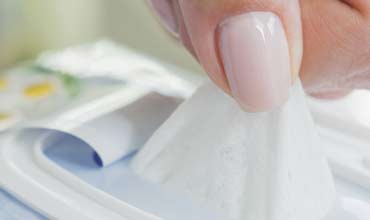
Are Baby Wipes Toxic? Here Are the Hidden Ingredients in Baby Wipes
Share

Baby wipes are an easy way to wipe off your baby's cute little bum. But baby wipes can contain hidden ingredients. Are baby wipes toxic? Learn more here.
If you're a parent today, it's easy to live in a world of semi-paranoia. As we learn more about the potential dangers of some of the chemicals commonly used in things we use, so many products and practices our parents trusted on a daily basis are now known to pose serious risks.
We're no longer in a time when you can trust the products in the baby aisle. To protect your kids, you need to inspect the label on every product you buy and look for natural baby care products.
Baby wipes are among the most surprising culprits. Are baby wipes toxic? It's not a "yes or no" question, but many mainstream brands do have some ingredients that can be harmful.
Toxic Hidden Ingredients in Baby Wipes
Many manufacturers often talk about how safe their listed ingredients are, however, this isn't always the full story. The problem lies in hidden ingredients.
Formaldehyde
Chances are that you've heard of formaldehyde. You may also know that it's a well-known carcinogen.
Before you panic, manufacturers aren't necessarily adding formaldehyde to their baby wipes. However, some do use certain preservatives that tend to release formaldehyde.
While it's not a sure-fire test, there are signs that can tell you if your baby wipes contain formaldehyde. It starts with a skin rash that's red, swollen, itchy, and bumpy. If the rash worsens, it can develop blisters that later break and develop a crust. The rash then becomes scaly and dry before turning the skin dark and leathery. If you have concerns, you should consult your child's pediatrician.
1,4-Dioxane
1, 4 Dioxane is another unintentional, yet still dangerous ingredient in many baby wipes.
Manufacturers use a process called ethoxylation to make their harsh raw materials less irritating to your baby's skin. However, 1,4-dioxane is a byproduct of that process that tends to stick around on the baby wipes.
Numerous health agencies have named 1,4-dioxane as a likely or possible carcinogen. It can also be a skin irritant.
To find baby wipes that won't contain 1,4-dioxane, avoid products that list any of these ingredients on their labels:
- Potassium Laureth Phosphate
- Polysorbate 20
- Bis-PEG/PPG-16/16 PEG/PPG-16/16 Dimethicone
- Ceteareth-20
- PEG-75 Lanolin
The names might not be easy to remember, but it's important to keep an eye out.
Phthalates
If you've been researching hidden ingredients and chemical dangers, you may have heard about phthalates. Like BPA, phthalates are present in many plastic bottles and can degrade into the beverages people drink.
When it comes to baby wipes, phthalates are common in the fragrances many manufacturers use. Phthalates are known hormone disruptors and have been shown to cause damage to the liver, kidneys, lungs, and reproductive system. They have even been banned in all cosmetics in the European Union.
Are Baby Wipes Toxic?
With all this information in mind, what's the verdict? Are baby wipes toxic? The answer is, "sometimes." While you won't find any of the hidden ingredients above listed on labels, they are potential risks as a result of the manufacturing process. Don't worry, because you don't have to stop using baby wipes altogether. The key is finding a brand you can trust that doesn't contain any of the hidden ingredients above.To find other safe baby products for your family, shop our selection of certified natural, toxin-free baby products.




